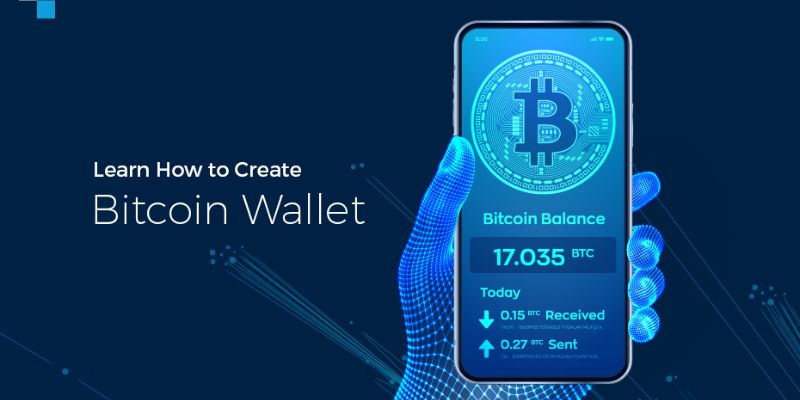Create a Bitcoin wallet – it’s not just a fad; it’s your digital treasure chest, and the security steps you take can make or break your peace of mind in the virtual currency world. Got fears about hacking or losing access to your hard-earned bitcoins? You’re in the right place to turn those fears into a fortress. In this guide, you’ll find a no-fluff, easy-to-follow blueprint that will walk you through the essentials of Bitcoin wallet types, setting up, maintaining, and using your wallet securely. Let’s dive deep into the digital realm and ensure your Bitcoin wallet stands strong against threats and mishaps.
Understanding Bitcoin Wallet Types and Their Security
Hot Wallet vs. Cold Wallet
Let’s talk about two kinds of bitcoin wallets: hot and cold. A hot wallet connects to the internet. You use it for daily trades. It’s like a purse you carry around. Popular hot wallets work on phones and computers. Think of hot wallets as easy to use but they can be risky if not secured right.
Cold wallets are offline. They’re like safes for your Bitcoin. You store big amounts of Bitcoin in cold storage. They’re less handy than hot wallets but safer. Use cold wallets to keep your Bitcoin secure over time. Remember, if you hold more Bitcoin, use a cold wallet to keep it safe.
Hardware Wallet Setup
Time to set up a hardware wallet. A hardware wallet is a kind of cold storage. It looks like a USB stick. This device keeps your private keys safe. It makes sure your Bitcoin is offline and away from hackers. You’ll plug it into your computer when you need to make transactions.
First, buy a hardware wallet from a trusted maker. Then, follow these steps:
- Plug the wallet into your computer.
- Install the software it asks for.
- Write down the seed phrase it shows you. This phrase lets you recover your wallet if you lose it.
- Set a strong PIN. Never share this with anyone.
- Your wallet will make a public address for Bitcoin. You’ll use this to receive Bitcoin.
Now your Bitcoin is safe. Make sure you keep the recovery seed in a secure place. It’s your backup plan.
When you need to move your Bitcoin, plug in the hardware wallet. Use your PIN, and send Bitcoin to others safely. Always unplug it when you’re done.
Hardware wallets are great for long-term storage. Mobile and desktop wallets are okay for smaller amounts and trades. Online services are riskier. They hold your keys, which can be dangerous. Always go for the wallet that fits how much Bitcoin you have and what you use it for.
Choosing the right wallet is about how you’ll use your Bitcoin. Do you buy coffee with it? A phone app wallet is fast and easy. Are you saving a lot of Bitcoin for later? Go with a hardware wallet.
Each wallet has its own setup and security steps. But all secure bitcoin storage comes down to keeping your private keys safe. And, knowing how to recover your wallet if needed. Keep your keys offline if you can. Also, think about extra steps like encryption and multifactor authentication. These steps make your wallet even safer.
Remember to check wallet choices for being user-friendly. But also, for meeting rules about money and privacy. Wallets for iOS and Android differ, so choose one that works with your device. Look at reviews and guides to find the best option. Always think of security when you set up bitcoin storage. It’s worth the extra time to keep your investment safe.

Step-by-Step Guide for Setting Up a Secure Bitcoin Wallet
Encryption for Wallet
Let’s keep things safe. When you set up bitcoin storage, think of it as your digital safe. Encryption is the lock on that safe. It scrambles your wallet data, making it tough for hackers to peek inside. To encrypt your new wallet, start by picking a strong password. Something long, with numbers and symbols. Imagine you are creating a secret code that only you know.
Keep this password safe and never share it. If you choose a software wallet for bitcoin, the app will guide you through encryption. It’s a must-do step. Locking your wallet is like putting a good lock on your door. It keeps the bad guys out.
Private Key Management
Now, let’s talk keys. Not the ones you use for your car but private keys. They’re a bunch of random letters and numbers. They’re like the key to your safe we talked about. It’s the only way to open it and get to your coins. You must keep this key secret. Lose it, and you lose your bitcoins too.
Here’s how to manage it right. First, when you create your wallet, you get your private key. Make sure you write it down and store it in a very safe place. Some people even lock it in a real safe.
For extra safety, use a hardware wallet. It keeps your key offline and safe from online attacks. Think of it as a secret vault. Only plug it in your computer when you need to use your bitcoins, like a bank visit.
Your wallet also gives you a seed phrase, like a backup key. Write it down, too. Store it somewhere different from the first key. If something happens to your computer, you can use the seed phrase to get back your coins.
And one more thing, turn on something called multifactor authentication. This is like having a guard check two IDs before you go in. It adds one more step to prove it’s really you trying to get in. It’s like a double lock on your door.
Remember, secure bitcoin storage isn’t hard. It just needs you to be careful and think of it as protecting real money. Because it is!
Next, we’ll move on to backups and recovery. It’s how you keep your coins safe, no matter what happens.

Maintaining and Backing Up Your Bitcoin Wallet
Backing Up Bitcoin Wallet
Your bitcoin wallet needs a backup, just like your phone does. This ensures you never lose access to your funds. It strikes many as a simple task, but I assure you, the peace of mind it brings is unmatched.
Start with writing down your seed phrase. A seed phrase is a group of words that store all the info needed to recover a bitcoin wallet. It’s your fail-safe, a critical backup to recover your funds if needed. Ensure you keep it in a safe, private place. I can’t stress this enough: if someone snags your seed phrase, they control your bitcoins.
It’s smart to double, even triple, your backup methods. Use a USB drive or a sturdy piece of paper. Far from prying eyes and potential digital mishaps, it’s a second layer of defense. Some go for a metal backup – fireproof, waterproof, and enduring. Think of it like a bitcoin bunker for your digital gold.
Now, you may want a cloud back up too. But, tread lightly. Encrypt this data like you’re guarding state secrets! Why? Cloud storage is handy, but it can be vulnerable to hacks.
Regularly update your backup. Add to it every time you create a fresh address or sign a new transaction. It doesn’t take long, but it could save you a world of trouble.
Recovering Bitcoin Wallet
So you need to recover your wallet? First, take a deep breath. Restoring access to your bitcoins is possible with your seed phrase. Grab that set of words you stowed away and input it into a new wallet app. Bam, just like that, your funds should pop up.
Did you forget to back it up? We’re in tricky territory. Without your seed phrase, recovery options dwindle. Some wallet apps have extra security like user-set passwords. If you’ve got that, you might stand a chance. Reach out to their support team. They can guide you through options you might not even know exist.
For hardware wallets, you’ll use the seed again. Plug in the new device, follow the prompts, and enter the phrase. If there was a PIN, put that in too. It’s a fresh start with your old funds.
Remember, your bitcoins’ safety rests heavily on your backup discipline. Keep your seed phrase secure and updated. That way, if the digital world ever goes sideways, you’re ready.
In sum, backup and recovery are your bitcoin lifelines. Guard them well, update them often, and rest easy knowing your digital treasure is safe.

Completing Transactions and Choosing Your Wallet
Bitcoin Transaction Fees and Syncing
When you send Bitcoin, you pay a small fee. This fee helps your transaction travel, like a ticket for a train. A higher fee might make your transaction go faster, because it becomes more appealing for the miners to process it first.
To set up bitcoin storage or a blockchain wallet setup, your wallet needs to sync with the network. This means it’s talking to other computers that have the Bitcoin ledger. Imagine a game where everyone’s score needs to update each time someone scores. Your wallet updates like this, so it knows all transactions are true.
Choosing a Bitcoin Wallet
When it’s time to pick a wallet, think about how you’ll use your Bitcoin. This will guide you in choosing a bitcoin wallet that’s right for you. If you often use your coins, a hot wallet on your phone or computer is good. It’s like keeping cash in your pocket – easy to use but not the safest place if you have a lot.
For big amounts, consider a cold wallet, like a safe box only you have the key to. This hardware wallet setup is like your private vault, away from the internet and safe. When you set up a hot wallet or cold wallet, your private key is the most important thing. Guard it like treasure, because it unlocks your coins.
Software wallet for bitcoin or mobile bitcoin app – pick these for a mix of security and comfort. They offer some safety but are still practical for everyday use, like a secured bag you carry day-to-day. Android bitcoin wallets or a bitcoin wallet for iOS let you manage your coins on the go.
Some like the bitcoin cold storage, which is the safest way to store large amounts of Bitcoin. It’s offline, so hackers can’t reach it. Think of it as locking your coins in a treasure chest and burying it. Only you know where it is and how to open it with your key.
To secure bitcoin storage, remember encryption for wallet is a must. This is like a secret code that scrambles your wallet info so only you can read it. Just like you wouldn’t send a secret letter without a code, don’t store your Bitcoin without encryption.
Digital currency wallet guides often recommend backing up your wallet. This means making sure you have a copy of your keys and wallet data stored in a safe place. If your computer dies, the backup is like having a spare key for your car.
As you choose your wallet, think about how you plan to use your Bitcoin, what kind of security you’re comfortable with, and whether you want to access your coins on the move. This choice shapes your Bitcoin experience. It’s about finding the balance between ease of use and safety—each wallet has its perks and risks.
Do some research, check online bitcoin wallet services, and read bitcoin wallet reviews. They are like maps that help you navigate the choices. Tutorials for wallet setup can walk you through making your wallet and sending and receiving bitcoin. Remember, it’s about what you need, how you’ll use it, and keeping your coins secure.
In this post, we’ve looked at the nuts and bolts of Bitcoin wallets, from the basics of hot and cold storage to the nitty-gritty of wallet setup and security. Setting up a strong encryption and keeping your private key safe are key steps to protect your digital dollars. Remember, backing up your wallet is crucial for peace of mind. And if trouble hits, knowing how to recover your wallet can save the day.
For everyday spending, a hot wallet might be your go-to, but for long-term savings, think about a cold wallet. The right balance will depend on your own needs. Don’t forget, fees and sync times can make or break your Bitcoin use, so choose a wallet that fits your patience and pocketbook.
Stay smart and stay secure – that’s the ticket to keeping your Bitcoin safe. Whether you’re just getting started or looking to tighten up your security, these tips will help keep your crypto coins in check. Remember, in this digital treasure chest, you hold the key.
Q&A :
How can I create a Bitcoin wallet for the first time?
Creating a Bitcoin wallet is a straightforward process. Generally, it involves choosing the type of wallet you need (hardware, desktop, mobile, web, or paper), downloading the relevant software if needed, setting up an account, and then securely storing the provided backup phrase or private key. For most software and mobile wallets, you’ll download an app or visit a website, follow the setup guide, and create a strong password to protect your wallet.
What are the most secure types of Bitcoin wallets?
When it comes to security, hardware and paper wallets are considered the most secure types of Bitcoin wallets because they store your private keys offline, away from potential online vulnerabilities. However, for a balance between security and convenience, many users prefer hardware wallets like Ledger or Trezor. It’s important to purchase these devices from reputable sources to prevent tampering.
What is the difference between a hot wallet and a cold wallet in Bitcoin?
A hot wallet is connected to the internet and includes mobile, desktop, and web wallets. They are convenient for daily transactions and easier to set up and access but are potentially more susceptible to online threats such as hacking. Conversely, a cold wallet refers to any Bitcoin wallet that is offline, like hardware wallets or paper wallets, providing a higher level of security at the cost of convenience.
Can I create a Bitcoin wallet without an ID?
Yes, creating a Bitcoin wallet typically does not require an ID. Most Bitcoin wallets don’t require personal information to set up. This is part of the decentralized and pseudonymous nature of cryptocurrencies. However, if you choose to purchase Bitcoin from a regulated exchange, you may need to provide an ID for verification purposes due to KYC (Know Your Customer) regulations.
What should I do if I lose access to my Bitcoin wallet?
If you lose access to your Bitcoin wallet, the first thing to do is to try to recover it using your backup phrase or recovery seed. This is a unique series of words provided when you first set up the wallet. It’s essential to keep this backup phrase safe and private. If you didn’t back up your wallet or you’ve lost your backup phrase, it’s challenging to regain access, and you could permanently lose your bitcoins. Always keep multiple backups of your recovery phrase in secure locations.


